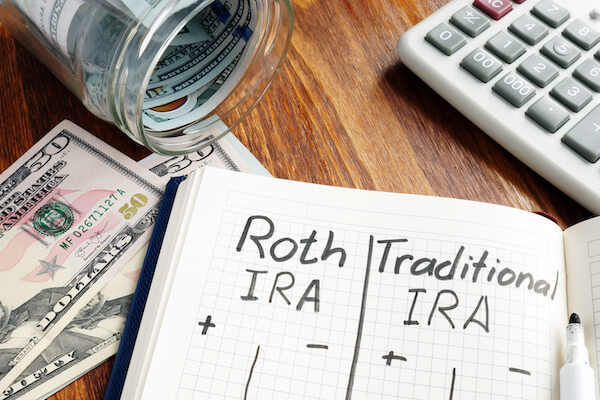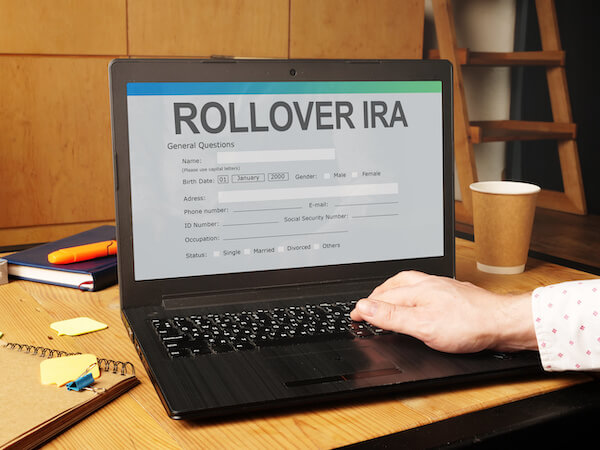
Death and taxes are the only certainties in life, as Benjamin Franklin said. Yet when it comes to your retirement plan, there is a way to save and invest almost tax-free: the Roth IRA. However, regulations do put an income limit on Roth IRAs. If you make above six figures, this retirement account is not available to you.
But, a loophole known as a backdoor Roth IRA can still help you save and keep your assets in a tax-free account. In this post, we’ll explain the differences between the traditional IRA and Roth IRA, tell you what exactly a backdoor Roth IRA is, and show you how you can take advantage of it.
Traditional IRA vs. Roth IRA

An individual retirement account (IRA) is a long-term savings account that individuals can use to save funds for a retirement. Unlike a 401(k), which is available only via an employer, anyone with an earned income can open an IRA.
You can open an IRA with a bank, a brokerage, or other approved financial institution. The two most common types of IRAs are the traditional and the Roth.
Traditional IRA
A traditional IRA is a trust that holds investments for retirement and offers some tax advantages for contributing to it.
For traditional IRAs, contributions are made pre-tax. You don’t pay taxes on the income that you put into the account. Instead, you pay taxes when you withdraw money during your retirement.
Traditional IRAs have required minimum distributions (RMDs). After a certain age, traditional IRAs mandate that you take out a portion of your retirement investments every year. And you’ll need to pay taxes on that income.
Roth IRA
A Roth IRA, named after Senator William Roth, is a special type of retirement account that is not taxed when you eventually take money from it.
Instead, for Roth IRAs, contributions are made with after-tax money. You’ve already paid income taxes on the money before you put it into the account.
Then, the account grows tax-free. Future interest payments, dividends, and capital gains that you earn from the investment are not taxed, and you don’t owe income tax when you take the money out during your retirement.
Because Roth IRA distributions are not taxed, the IRS doesn’t require minimum distributions during retirement. If you want, you can leave that capital to your heirs or donate it.
At the same time, Roth IRAs also give you the flexibility of penalty-free early withdrawals of contributions. For investment earnings in your Roth IRA, there is usually a 10% penalty if you withdraw before age 59 and a half.
In general, a Roth IRA account is preferable in two cases:
- You expect higher taxes in the future.
- You expect to be in a higher tax rate bracket during retirement.
IRA Contribution Limits and Income Limits
As of 2021, you can contribute $6,000 a year across all your individual retirement accounts. For account owners who are over 50 years old, the limit is $7,000. The important thing to keep in mind is that this is a combined limit across all your IRAs (no matter which type they are) and not the limit for each IRA you have.
However, Roth IRAs also have income limits. As of tax year 2021, if you want to contribute to a Roth IRA, your maximum adjusted gross income (AGI) must be under $140,000 if you file as a single person. For married couples who file jointly, your AGI must be under $208,000. There are some allowable deductions and tax penalties, so if your income is around that threshold, it’s important to consult a tax professional.
If your income is already well-above that level, you might want to consider using a backdoor Roth IRA.
What Is a Backdoor Roth IRA?
Despite the nickname, the backdoor Roth IRA is not something dodgy. It’s a completely legal process of switching from another retirement saving account into a Roth IRA.
If you’re a high-income earner, you can get over the Roth IRA income limits by first making non-deductible contributions to a traditional IRA. After that, you can roll over the traditional IRA into a Roth IRA. Because this operation doesn’t count as a contribution, there are no income limits for it.
Keep in mind, in September 2021, the Senate started to review the existing legislation, so this loophole might be closed in the future.
How to Do a Backdoor Roth IRA Conversion

For an individual investor, a backdoor Roth strategy is not complicated. Most brokers and banks can do all the paperwork for you. Here are the steps you will need to take.
1. Open a Traditional IRA Account
You can open any traditional individual retirement account or even use one you already have. There is no limit to how many IRA accounts you can have. So if your broker doesn’t offer a Roth IRA conversion, you can simply open a new IRA with a brokerage that does.
2. Make Your Traditional IRA Contributions
You can contribute pre-tax (deductible) or after-tax dollars. It doesn’t matter because you will still need to pay the taxes for deductible money when you convert into a Roth IRA.
3. Open a Roth Account
You could open a new Roth IRA with the same broker or a different one. Initially, this account will be empty, and you won’t be able to make direct contributions if your income is above the limit.
4. Rollover the Traditional IRA Into the Roth IRA
Request your traditional IRA administrator (i.e., your brokerage or bank) to do a direct rollover, which is also known as a trustee-to-trustee rollover. Your IRA administrator will provide all the required documents and will deposit the funds into your Roth IRA within 60 days.
5. Pay Taxes
If your traditional IRA contributions were tax-deferred, you will need to pay taxes on the money when you roll it over.
A rollover is not considered a Roth IRA contribution. Instead, the IRS will view it as income. Keep this in mind, as this might push you into a higher income tax bracket on your tax return. A good idea might be to roll over just enough to stay in your lower tax bracket. You’ll also want to be familiar with the pro-rata rule.
6. Keep the Money in the Roth IRA for at Least Five Years
When you use the backdoor Roth, a five-year rule will kick in. If you withdraw funds within the first five years, you will need to pay a 10% penalty. You might also end up with additional taxes to pay. After five years, however, you can withdraw tax-free money just like you would from a regular Roth IRA.
It’s important to check with your financial advisor because a backdoor Roth IRA might result in tax implications, either when you do the rollover or if you withdraw funds early.
Over the long term, however, a Roth IRA is a great way to build a retirement portfolio without paying capital gains tax.
Lay the Foundation for Your Retirement
In this article, we’ve explored the differences between traditional and Roth IRAs and then outlined how you can use a backdoor Roth IRA to create a tax-free account, even if your income is above the limit.
The great thing about a Roth IRA is that you don’t need to worry about future tax bills. You can keep both dividend stocks and growth stocks and just focus on growing your portfolio.
To find high-quality dividend stocks for your Roth IRA investments, subscribe to Investors Alley’s Dividend Hunter newsletter.





